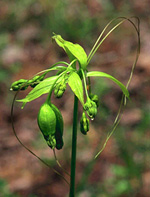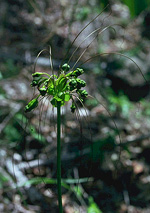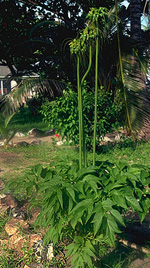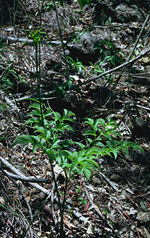 |
This is a small, narrowly tropical family, most species of which occur in south-east Asia. Two species grow in monsoonal woodlands in northern Australia, from the Kimberley region of Western Australia to Cape York, Queensland.
Characteristic features of the family Taccaceae in Australia include: - robust, perennial herbs with tubers or thick, fleshy rhizomes and few, large, irregularly-divided (but basically 3-lobed) leaves arising from ground level
- flowers small, green or purple, borne in a head-like umbel subtended by several broad bracts and interspersed with long, erect or drooping filaments
- perianth of 6 segments fused at the base into a tube
- ovary inferior, developing into a dark-coloured fleshy berry
Description
Perennial terrestrial herbs. Perennating by rhizomes or tubers. Vegetative reproduction by tubers. Internal secretions not obvious. Plants glabrous. Leaves all or mostly basal, petiolate. Stipule-like lobes absent. Lamina conspicuously asymmetric, bicompound, ternate, pinnatifid, pinnatisect, palmatifid, palmatisect, bipinnatifid, tripinnatifid, etc, or rarely simple; lamina/lobes filiform, acicular, subulate, linear, lanceolate or ovate; base rounded or oblique; margins entire, ±flat; venation pinnate, with the midrib conspicuous, and the tertiary venation not reticulate; surfaces not punctate; herbaceous. Leaf ligule absent. All the flowers bisexual. Inflorescences terminal, consisting of umbels. Bracts present. Pollination by insects. Flowers ?malodorous, stalked. Floral disc present or absent; nectaries absent. Perianth regular, of 2 ±similar whorls, usually with 6 fused petaloid segments, imbricate in bud, yellow, purple or green, without contrasting markings, membranous or herbaceous. Fertile stamens 6, opposite to and at least partly fused to the perianth segments, free of the ovary and style, distinct from each other, all ±equal. Staminal filaments distinctly flattened. Anthers dorsifixed, not versatile, opening outwards by longitudinal slits, 2-celled. Ovary inferior. Carpels 3, fused; ovary with 1 locule. Style terminal, single and unbranched, or single and branched above. Ovules numerous, sessile; placentation parietal. Fruit a fleshy, indehiscent berry; the perianth on the maturing fruit dry and persistent. Disseminule macro-surface costate; micro-surface ±smooth, yellow, green or brown, dull. Seeds numerous per fruit. Aril absent. Cotyledons 1. Embryo straight.
(Note: this description has been generated from the coded data compiled for the key. Any errors in the key data will be reflected in the descriptions.)
A treatment of the family Taccaceae has been published in:
Flora of Australia 46: 174-176.
Australian genera of Taccaceae (as recognised for the Flora of Australia)
Tacca

|
  |

Tacca leontopetaloides (flowers)
Photo: D.Jones © D.Jones

Tacca leontopetaloides (flowers)
Photo: G.Butler © ANBG

Tacca leontopetaloides (fruiting plant)
Photo: D.Jones © D.Jones

Tacca leontopetaloides (habit)
Photo: G.Butler © ANBG
|
 |
|